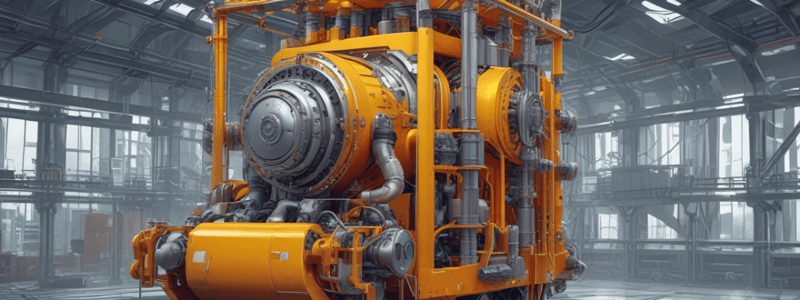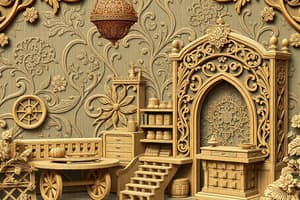Podcast
Questions and Answers
What is the commercial classification of plastics?
What is the commercial classification of plastics?
- A natural material formed without any human intervention
- A material with a precise scientific definition
- A synthetic material that can be shaped during manufacture (correct)
- A specific type of metal alloy
Which of the following is NOT a common source used to create plastics?
Which of the following is NOT a common source used to create plastics?
- Cotton
- Coal
- Leather (correct)
- Natural gas
Which component is referred to as an alternative term for plastic?
Which component is referred to as an alternative term for plastic?
- Stabilizer
- Plasticizer
- Resin (correct)
- Filler
What role do stabilizers play in the formation of plastics?
What role do stabilizers play in the formation of plastics?
Which processing method is NOT used for plastics?
Which processing method is NOT used for plastics?
What advantage does blow molding offer for plastic production?
What advantage does blow molding offer for plastic production?
Why are fillers added to plastics?
Why are fillers added to plastics?
Which of the following items is typically made using injection molding?
Which of the following items is typically made using injection molding?
What material is used as water-repellent fabric finishes and joint sealants?
What material is used as water-repellent fabric finishes and joint sealants?
Which material is commonly used for cushioning in seating and mattresses?
Which material is commonly used for cushioning in seating and mattresses?
Why are plastics advantageous for use in electrical insulation?
Why are plastics advantageous for use in electrical insulation?
Which material is used for making molded dishes and countertops?
Which material is used for making molded dishes and countertops?
Which material can be used for electrical and heat-resistant applications, but is limited to dark colors?
Which material can be used for electrical and heat-resistant applications, but is limited to dark colors?
What is the base element for silicones that differentiates them from other plastics?
What is the base element for silicones that differentiates them from other plastics?
What property makes plastics advantageous in the fabrication of intricate parts?
What property makes plastics advantageous in the fabrication of intricate parts?
Which component is frequently utilized in fiberglass construction and as an adhesive?
Which component is frequently utilized in fiberglass construction and as an adhesive?
Which material is obtained through a process developed by General Electric in the 1940s?
Which material is obtained through a process developed by General Electric in the 1940s?
Which plastic is known for being dimensionally stable and resistant to stains and chemicals?
Which plastic is known for being dimensionally stable and resistant to stains and chemicals?
Which polyolefin is known for its strength and flexibility?
Which polyolefin is known for its strength and flexibility?
What is the largest market for polybutylenes (PB)?
What is the largest market for polybutylenes (PB)?
What is one common use of polyethylene in commercial interiors?
What is one common use of polyethylene in commercial interiors?
Which material is particularly noted for being the lightest of all commercial plastics?
Which material is particularly noted for being the lightest of all commercial plastics?
Which plastic is known for its sparkling clarity and extreme ease of processing?
Which plastic is known for its sparkling clarity and extreme ease of processing?
What is a common use for polyvinyl chloride (PVC) in the Interior Design Industry?
What is a common use for polyvinyl chloride (PVC) in the Interior Design Industry?
Which material has been used as an interlayer in safety glass since 1938?
Which material has been used as an interlayer in safety glass since 1938?
What happens to thermosets when they are heated after forming?
What happens to thermosets when they are heated after forming?
Which plastic is used for resilient floor tile, films, pipes, and paint lacquers?
Which plastic is used for resilient floor tile, films, pipes, and paint lacquers?
What characteristic does polystyrene exhibit in sheet form?
What characteristic does polystyrene exhibit in sheet form?
Flashcards are hidden until you start studying
Study Notes
Definition of Plastics
- Plastics are materials of synthetic origin that can be shaped during manufacture.
- They are not rubber, wood, leather, or metal.
- Made from common sources like coal, salt, natural gas, cotton, wood, and water.
- Sources are used to create monomer chemicals, which are then built into chain-like molecules called polymers.
Characteristics of Plastics
- Polymers have low extensibility.
- Can be molded, extruded, cut, or worked into different shapes and objects.
- Can be rigid or non-rigid, light or heavy, heat-resistant or easily softened by hot water.
- Like metals, plastics can be mixed with other materials to improve their characteristics.
Components of Plastics
- Resin: The basic component of plastic.
- Fillers: Added to change a characteristic, like durability or heat resistance.
- Stabilizers: Offer protection against degradation from exposure to ultraviolet rays or oxygen.
- Plasticizers: Make a material more flexible, resilient, and impact resistant.
Processing Methods
- Injection Molding: Produces moldings of high quality and accuracy, often used with thermoplastics.
- Blow Molding: Used with extrusion, suitable for making hollow plastic products.
Types of Plastics
- Polyolefins: A family of plastics, including polybutylenes, polyethylenes, and polypropylenes.
- Polybutylenes: Exhibit good retention of mechanical properties at elevated temperatures and high tensile strength.
- Polyethylenes: Known for their strength and flexibility, used for electrical wire insulation and vapor barriers.
- Polypropylene: The lightest of all commercial plastics, used in many fabrication methods, including upholstery fabric and carpet backing.
- Polystyrene: Inexpensive and easy to process, known for their sparkling clarity and hardness.
- Vinyls: A large group of plastics, including polyvinyl chloride (PVC) and polyvinyl butyral (PVB).
- PVC (Polyvinyl Chloride): Resin itself is rigid, plasticizers add flexibility, used for pipes, floor tile, and paint lacquers.
- PVB (Polyvinyl Butyral): Used as an interlayer in safety glass and as a textile coating.
- Thermosets: Cannot be softened and remolded once set, resist higher temperatures.
Applications of Plastics
- Floor and Gymnasium Finishes: Powder coatings based on heat-cured epoxy resins.
- Melamine and Urea: Hard, durable, clear, and dimensionally stable, resistant to stains, chemicals, electrical potential, and heat.
- Phenolic: Strong, durable, and heat-resistant, limited to dark colors.
- Polyesters: Include a large family of plastics, used for fiberglass, laminating materials, and contact adhesives.
- Silicones: Unique among plastics, based on the silicon atom, used for water-repellent fabric finishes and joint sealants.
- Urethane: Appears as flexible and rigid foams and coatings, also as adhesive and sealants.
Advantages of Plastics
- Ease of Fabrication: Readily adaptable to mass production methods, intricate parts can be easily made.
- Weight-Saving: Density parts of plastics are less than that of metals.
- Resistance to Corrosion: Most plastic parts are immune to rust, rot, or corrosion.
- Electrical Insulation: Does not conduct electricity, hence it is a good preventive against electrical shocks.
- Thermal Insulation: Plastics are poor heat conductors, used in control handles and steering wheels.
Studying That Suits You
Use AI to generate personalized quizzes and flashcards to suit your learning preferences.



